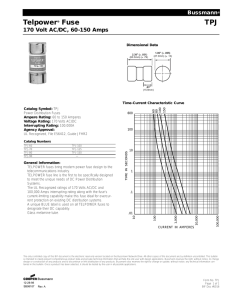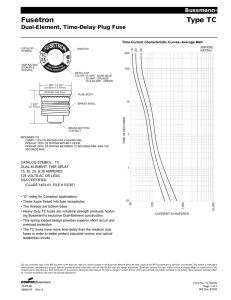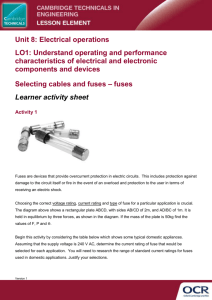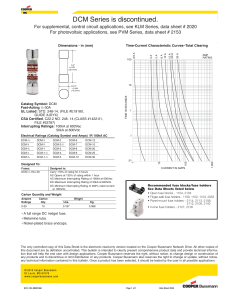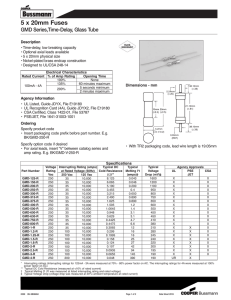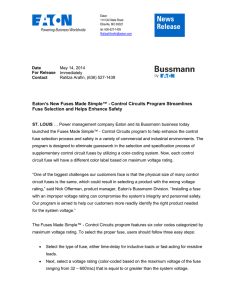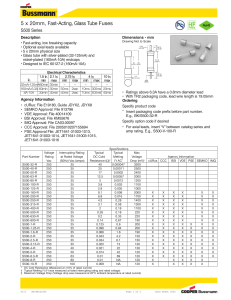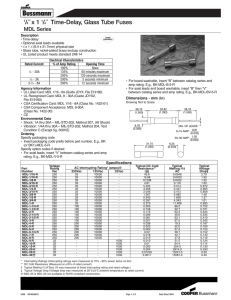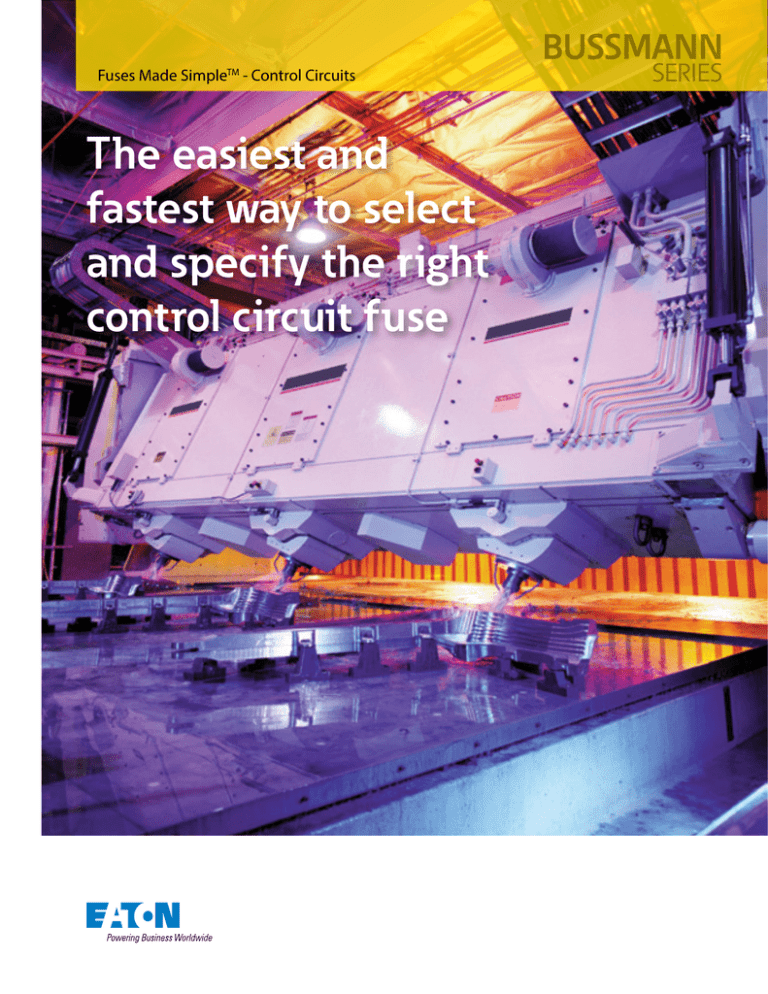
Fuses Made SimpleTM - Control Circuits
The easiest and
fastest way to select
and specify the right
control circuit fuse
BUSSMANN
SERIES
Fuses Made SimpleTM - Control Circuits
Eaton's Bussmann® series Fuses Made Simple program provides the easiest and fastest way to select and specify the right
fuse. Whether it’s branch circuit or control circuit (supplemental) fuses, we take the guesswork out of selecting the right fuse.
With Fuses Made Simple - Control Circuits, we make it simple to replace control circuit fuses with six color coded groups
(categorized by voltage rating) ‐ all while enhancing the safety of the electrical system.
Find the Bussmann series control circuit fuse you need in three simple steps:
1
Type
Select the fuse type. Select from time-delay for inductive loads or fast-acting for resistive
loads.
2
Voltage
Select the voltage rating needed. Keep in mind that the fuse voltage rating must be equal
to or greater than the circuit voltage.
3
Interrupting
ratings
Verify that the interrupting rating of the fuse selected is sufficient for the circuit
application. Keep in mind that the interrupting rating must be equal to or greater than the
available fault current.
Use the following table to find and select the right Bussmann series control circuit fuse:
600Vac
Time- delay
Family
Low-Peak™Class CC
(LP-CC) fuse
recommended*
FNQ
Interrupting
rating
10kA
Family
Interrupting rating
Family
FNQ
35kA (1/10-1 amp)
100A (1 1/3- 3 1/2 amp)
200A (4-10 amp)
10kA (12-30 amp)
35A (1/10- 8/10 amp)
200A (1-6 amp)
FNQ
10ka
(1/10-30 amp)
KTK
100A
KLM
BSS
3
1
48Vac
125Vac
Interrupting
rating
FNA2
Interrupting
Family rating
Fast-acting
250Vac
500Vac
Interrupting
Family rating
Upgrade to 125Vac
Upgrade to 600Vac
FNQ
Interrupting rating
35kA
MIC2 35A (1amp)
100A (2-3amp)
200A (5-10amp)
750A (15amp)
(1/10- 30 amp)
(1/4 -1 amp)
100kA
100A
(1/10-30 amp)
(1 1/2- 3 amp)
10kA
200A (4-10 amp)
750A (12-15 amp)
200A (20- 30 amp)
10A (7-10 amp)
(1/10-6 amp)
BSS1
FNA2
1kA (20-30 amp)
Family
Interrupting
rating
MIC2
10kA (20-30 amp)
(6 1/4- 15 amp)
Family
32Vac
Upgrade to 250Vac
Family
Interrupting
rating
BSS1
kA**
(12-30 amp)
https://www.linkedin.
com/company/eatonselectrical-sector
For ultimate protection, any of the control circuit fuses above can be upgraded to a branch circuit rated Bussmann series Low-Peak™ Class CC
fuse (LP-CC).
1
2
3
Fuse is 1‐3/8" long
Fuse is pin indicating
Fuse is also rated for 600Vdc.
*For primary protection of control transformers, use FNQ-R.
**For interrupting rating, contact factory.
Color-coded by voltage
Each fuse label has a unique identifying color band that represents the fuse’s maximum voltage rating. When it’s time to replace a fuse, Eaton's
Bussmann Division makes it easy to search for the replacement. Select the voltage needed by simply looking for the Bussmann series fuse with
the right color band in the storage bin. This narrows the search and speeds replacement time.
Easy selection by application
Fast-acting
Application*
1
General purpose, non-inductive loads
2
277V lighting circuits
3
Meter circuits
4
Any non-inductive load 600Vac and less
5
Any non-inductive load 250Vac and less
6
DC control circuits up to 600Vdc
7
480V primary control transformer protection
8
DC control circuits requiring fast-acting fuses
9
Lighting circuit protection
10
250V and less secondary control transformer protection
11
Lighting ballasts
12
PLC circuits
13
Electronic circuits
14
Control circuits
15
Solenoids (coils)
16
Power supply
17
Appliances
18
Flexible and extension cords
19
Control relay
20
Photovoltaic source circuits
21
Motor control circuits
22
Auxiliary and signal contacts
23
Amplifier protection
24
Contactors
25
Testing equipment (meters)
26
Receptacles
KTK
BAF
BBS
Time-delay
KLM
MIC
FNQ
FNA
FNM
*Applied in circuits already properly protected by a branch circuit overcurrent protective device or when recognized by the NEC® to provide equivalent branch circuit overcurrent protection.
Complementary products
In addition to supplemental control circuit fuses, Bussmann series offers a broad portfolio of circuit protection solutions.
Visit Eaton.com/bussmannseries to learn more.
Additional fuse portfolio
Fuses Made SimpleTM
UL low voltage
Class CF time-delay and
fast-acting CUBEFuse™ UL fuses
High speed fuses
Electronic and
small dimension
fuses
Finger-safe power
distribution blocks
Class CC, midset and PV
compact modular fuse holders
Fuse holders, blocks, and power distribution blocks
Class J power distribution
fuse blocks
Class CC and supplemental
modular ferrule fuse blocks
Disconnect switches and safety switches
CUBEFuse Compact Circuit
Protectors (CCP_CF)
Class CC and midget Compact
Circuit Protectors (CCP)
Fused rotary
disconnect switchs
Non-fused rotary
disconnect switches
Surge protective devices
Type 1 SurgePODTM
HEAVY DUTY SPD's
Type 2 DIN-Rail SPDs
DIN-Rail data signal
SPDs
BNC coaxial cable
data signal SPDs
Enhanced safety
Importance of voltage rating and interrupting rating
Control circuit fuses have many different voltage ratings, ranging
from 32 to 600Vac, and interrupting ratings up to 100kA. Because
their physical size does not vary with voltage or interrupting
ratings, the most frequent cause of misapplication is due to
improper voltage or interrupting rating selection. This leads to
compromised system integrity, and equipment and personnel
safety. It is important to note, though, that when a fuse is applied
beyond its ratings, there may not be any initial indicators. Adverse
consequences typically result when a system fault occurs and an
improperly sized fuse attempts to interrupt an overcurrent event.
Voltage rating
Interrupting ratings
Voltage rating is extremely important. The proper application of
an overcurrent protective device, according to its voltage rating,
requires that the voltage rating of the device be equal to or greater
than the system voltage. It can be higher but not lower. For instance,
a 600V fuse can be used to safely protect a 208V circuit. However,
when an overcurrent protective device is applied beyond its rating,
there may be potential for fire and arcing energy, which poses a
severe fire risk to other components in the panel.
protective device must be able to withstand the destructive energy
of fault currents of the equipment it is protecting. If a fault current
exceeds a level beyond the capacity of the protective device,
the device may actually rupture, causing additional damage. It
is therefore important when applying a fuse to use one that can
sustain the largest potential fault currents. Failure to apply fuses
with the appropriate interrupting rating can be a serious safety
hazard.
Interrupting rating is also of critical importance. An overcurrent
Fuses Made Simple - Control Circuits helps enhance safety
Consistent look for each label
Bussmann's series Fuses Made Simple - Control Circuits helps
minimize the risk of misapplication by clearly and consistently
indicating both the voltage rating and interrupting rating on the
fuse label. The voltage rating is easily identified by both the color
code band and the large print on the fuse label. Additionally, the
interrupting rating is printed on the side of each fuse.
Every fuse label now has a consistent look. Critical fuse information
is presented in an easy-to-read format across the entire Bussmann
series control circuit fuse portfolio to help speed replacement.
Clearly identify the
voltage by color
Easy-to-read voltage and
type
Date code
Voltage rating
Agency
information
Interrupting
rating
Interrupting rating
FNQ-30
Consistent location of part
number and amperage
Eaton
1000 Eaton Boulevard
Cleveland, OH 44122
United States
Eaton.com
Bussmann Division
114 Old State Road
Ellisville, MO 63021
United States
Eaton.com/bussmannseries
© 2015 Eaton
All Rights Reserved
Printed in USA
Publication No. 10223
December 2015
For Eaton’s Bussmann series
product information,
call 1-855-287-7626 or visit:
Eaton.com/bussmannseries
Eaton, Bussmann, CUBEFuse, Fuses Made
Simple, SurgePOD and Low-Peak are
valuable trademarks of Eaton in the US
and other countries. You are not permitted
to use the Eaton trademarks without prior
written consent of Eaton.
NEC is a registered trademark of the
National Fire Protection Association, Inc.
Follow us on social media to get the
latest product and support information.

